Wednesday, April 22, 2009
California's Geology
California's remarkable geology is the result of volcanic and tectonic activity. Its majestic mountains were shaped by glaciers during the ice ages as well as by wind and rain. The scenic coastline of California is continually shaped by the pounding waves of the Pacific Ocean. California has a wealth of mineral resources, including the rich soil of the Central Valley, the gold of the Sierra, and oil off the coast and in various locations across the state. :)
Monday, April 20, 2009
Mid-Ocean Ridges
Mid-Ocean Ridges an underwater mountain range, typically having a valley known as a rift running along its spine, formed by plate tectonics. At the mid-ocean ridge, the lava rises and erupts. Soon the lava cools and hardens. That part becomes the new crust. That's how the continents move. As the mid-ocean ridges move apart, its literally renewing the crust, as the older crust is recycled back into the mantle.
Saturday, April 18, 2009
Pangea
Have you heard of the word Pangea? No? Is this in your mind? What's pangea? Come on i'll tell you! There's a long story for that! Millions of years ago, scientist believe that all the continents today were all once together like a jigsaw puzzle. It's called the 'supercontinent' otherwise known as Pangea. Then the continents broke apart and split to different directions. The scientist think that the continents are still moving and will once again come back together, Pangea. The theory that made the scientists think that the continents move apart is caused by continental drift. Continental Drift is where two plates slide by each other.
Friday, April 10, 2009
3 Different Types of Boundaries
When the plates meet, there are SO MANY THINGS THAT CAN HAPPEN!
Thats why there are different types of boundaries. Some can slide past each other, while others will collide into each other! And so, there are three main types of plate boundaries.
The first is Convergent. Convergent boundaries slide towards each other, as one will go under the other, and magma comes through the crack. Thats how volcanoes are formed. Most of the time, the collision is made of a oceanic plate, and a continental plate. Its like eating an Oreo(America's Favorite Cookie!). When you split it in half, there's the cream inside. If you take the other cookie side, and slide it on top the cookie with the cream, the cream, goes off the cookie, and above its former place, onto the OTHER COOKIE!!! SIGH. NOW I WANT A COOKIE!!! :(
The second is Divergent. Divergent boundaries move away from each other, as magma seeps through the opening, making more land. Divergent boundaries are mostly found in the ocean, and thats how islands were formed! Divergent boundaries form places like Hawaii.
The FINAL plate boundary(well, actually there are lots more, but these are the main ones.), is Transform Boundaries. They slide past each other, just like how earthquakes occur.
Thursday, April 9, 2009
Volcanoes and the Ring of Fire
Volcanoes. In your mind, you just thought of lots of lava oozing out and hardening into magma and an eruption right? That's what I think of when I think of volcanoes too. Some people don't know the answer to this simple question. What is a volcano? There's more than just to a volcano erupting and volcano oozing out and turning to magma. You've got a lot to learn!
Volcanoes are an open mouth that leads down to an underground full of lava. When pressure builds up, eruptions occur. Rocks, gas, and lava shoot out. Once the lava has ben set on the ground, it cools and turns into magma! Hard rock. Why do volcanoes erupt? There are plates underneath the earth that move. When two plates collide, one of the plate goes on top of each other. This causes the lava to move upwards and erupt like a volcano.
Sure, but where do volcanoes come from? Volcanoes are formed from convergent boundaries. When two plates collide magma seeps through forming volcanoes!
Tuesday, April 7, 2009
How well do YOU know the Earth? Take our quiz we made and find out!
http://www.quizyourfriends.Plate Tectonics and Plate Boundaries
Plate tectonics is a theory that the Earth crust is divided into plates that move. These plates move at 1 cm per year, the rate of growing finernails.
Tectonics are divided into plates.Each of the plates meet together at faults. At each fault there is something called a plate boundary. Plate boundaries are where plates meet together, but when two plates meet together, there are numerous things that could happen. There are different types of plate boundaries. There are 3 main types of plate boundaries- convergent boundaries, divergent boundaries, and transform boundaries.
Uh.....what?
Think of it this way.
You're drinking hot chocolate, and you enjoy it with marshmallows. The marshmallows float to the top. So the marshmallows are the Earth's crust, divided into plates, and the hot chocolate is the mantle(more on that later.).
Subscribe to:
Posts (Atom)







